Tao Lei
Representation Discrepancy Bridging Method for Remote Sensing Image-Text Retrieval
May 22, 2025Abstract:Remote Sensing Image-Text Retrieval (RSITR) plays a critical role in geographic information interpretation, disaster monitoring, and urban planning by establishing semantic associations between image and textual descriptions. Existing Parameter-Efficient Fine-Tuning (PEFT) methods for Vision-and-Language Pre-training (VLP) models typically adopt symmetric adapter structures for exploring cross-modal correlations. However, the strong discriminative nature of text modality may dominate the optimization process and inhibits image representation learning. The nonnegligible imbalanced cross-modal optimization remains a bottleneck to enhancing the model performance. To address this issue, this study proposes a Representation Discrepancy Bridging (RDB) method for the RSITR task. On the one hand, a Cross-Modal Asymmetric Adapter (CMAA) is designed to enable modality-specific optimization and improve feature alignment. The CMAA comprises a Visual Enhancement Adapter (VEA) and a Text Semantic Adapter (TSA). VEA mines fine-grained image features by Differential Attention (DA) mechanism, while TSA identifies key textual semantics through Hierarchical Attention (HA) mechanism. On the other hand, this study extends the traditional single-task retrieval framework to a dual-task optimization framework and develops a Dual-Task Consistency Loss (DTCL). The DTCL improves cross-modal alignment robustness through an adaptive weighted combination of cross-modal, classification, and exponential moving average consistency constraints. Experiments on RSICD and RSITMD datasets show that the proposed RDB method achieves a 6%-11% improvement in mR metrics compared to state-of-the-art PEFT methods and a 1.15%-2% improvement over the full fine-tuned GeoRSCLIP model.
IDEA Prune: An Integrated Enlarge-and-Prune Pipeline in Generative Language Model Pretraining
Mar 07, 2025Abstract:Recent advancements in large language models have intensified the need for efficient and deployable models within limited inference budgets. Structured pruning pipelines have shown promise in token efficiency compared to training target-size models from scratch. In this paper, we advocate incorporating enlarged model pretraining, which is often ignored in previous works, into pruning. We study the enlarge-and-prune pipeline as an integrated system to address two critical questions: whether it is worth pretraining an enlarged model even when the model is never deployed, and how to optimize the entire pipeline for better pruned models. We propose an integrated enlarge-and-prune pipeline, which combines enlarge model training, pruning, and recovery under a single cosine annealing learning rate schedule. This approach is further complemented by a novel iterative structured pruning method for gradual parameter removal. The proposed method helps to mitigate the knowledge loss caused by the rising learning rate in naive enlarge-and-prune pipelines and enable effective redistribution of model capacity among surviving neurons, facilitating smooth compression and enhanced performance. We conduct comprehensive experiments on compressing 2.8B models to 1.3B with up to 2T tokens in pretraining. It demonstrates the integrated approach not only provides insights into the token efficiency of enlarged model pretraining but also achieves superior performance of pruned models.
Instruction-Following Pruning for Large Language Models
Jan 07, 2025



Abstract:With the rapid scaling of large language models (LLMs), structured pruning has become a widely used technique to learn efficient, smaller models from larger ones, delivering superior performance compared to training similarly sized models from scratch. In this paper, we move beyond the traditional static pruning approach of determining a fixed pruning mask for a model, and propose a dynamic approach to structured pruning. In our method, the pruning mask is input-dependent and adapts dynamically based on the information described in a user instruction. Our approach, termed "instruction-following pruning", introduces a sparse mask predictor that takes the user instruction as input and dynamically selects the most relevant model parameters for the given task. To identify and activate effective parameters, we jointly optimize the sparse mask predictor and the LLM, leveraging both instruction-following data and the pre-training corpus. Experimental results demonstrate the effectiveness of our approach on a wide range of evaluation benchmarks. For example, our 3B activated model improves over the 3B dense model by 5-8 points of absolute margin on domains such as math and coding, and rivals the performance of a 9B model.
Distribution alignment based transfer fusion frameworks on quantum devices for seeking quantum advantages
Nov 04, 2024



Abstract:The scarcity of labelled data is specifically an urgent challenge in the field of quantum machine learning (QML). Two transfer fusion frameworks are proposed in this paper to predict the labels of a target domain data by aligning its distribution to a different but related labelled source domain on quantum devices. The frameworks fuses the quantum data from two different, but related domains through a quantum information infusion channel. The predicting tasks in the target domain can be achieved with quantum advantages by post-processing quantum measurement results. One framework, the quantum basic linear algebra subroutines (QBLAS) based implementation, can theoretically achieve the procedure of transfer fusion with quadratic speedup on a universal quantum computer. In addition, the other framework, a hardware-scalable architecture, is implemented on the noisy intermediate-scale quantum (NISQ) devices through a variational hybrid quantum-classical procedure. Numerical experiments on the synthetic and handwritten digits datasets demonstrate that the variatioinal transfer fusion (TF) framework can reach state-of-the-art (SOTA) quantum DA method performance.
EC-DIT: Scaling Diffusion Transformers with Adaptive Expert-Choice Routing
Oct 02, 2024



Abstract:Diffusion transformers have been widely adopted for text-to-image synthesis. While scaling these models up to billions of parameters shows promise, the effectiveness of scaling beyond current sizes remains underexplored and challenging. By explicitly exploiting the computational heterogeneity of image generations, we develop a new family of Mixture-of-Experts (MoE) models (EC-DIT) for diffusion transformers with expert-choice routing. EC-DIT learns to adaptively optimize the compute allocated to understand the input texts and generate the respective image patches, enabling heterogeneous computation aligned with varying text-image complexities. This heterogeneity provides an efficient way of scaling EC-DIT up to 97 billion parameters and achieving significant improvements in training convergence, text-to-image alignment, and overall generation quality over dense models and conventional MoE models. Through extensive ablations, we show that EC-DIT demonstrates superior scalability and adaptive compute allocation by recognizing varying textual importance through end-to-end training. Notably, in text-to-image alignment evaluation, our largest models achieve a state-of-the-art GenEval score of 71.68% and still maintain competitive inference speed with intuitive interpretability.
Apple Intelligence Foundation Language Models
Jul 29, 2024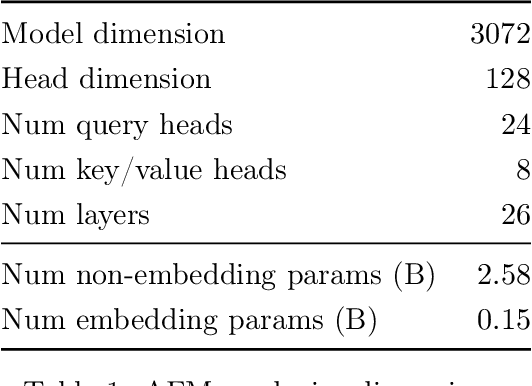
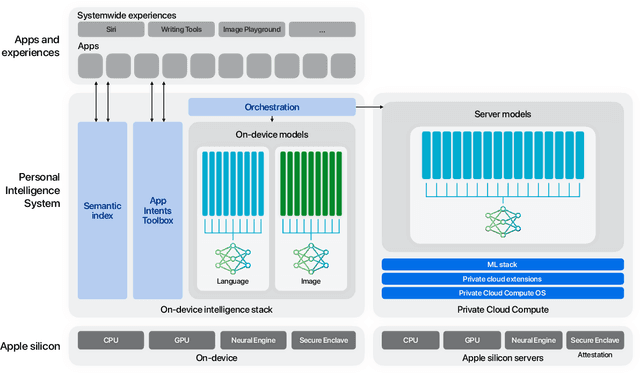

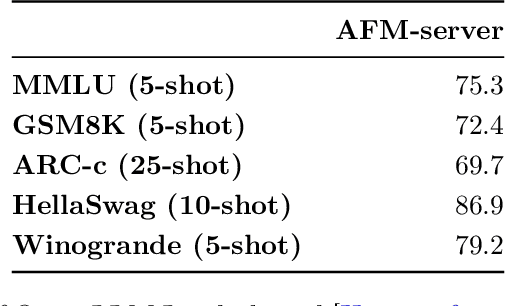
Abstract:We present foundation language models developed to power Apple Intelligence features, including a ~3 billion parameter model designed to run efficiently on devices and a large server-based language model designed for Private Cloud Compute. These models are designed to perform a wide range of tasks efficiently, accurately, and responsibly. This report describes the model architecture, the data used to train the model, the training process, how the models are optimized for inference, and the evaluation results. We highlight our focus on Responsible AI and how the principles are applied throughout the model development.
MM1: Methods, Analysis & Insights from Multimodal LLM Pre-training
Mar 22, 2024



Abstract:In this work, we discuss building performant Multimodal Large Language Models (MLLMs). In particular, we study the importance of various architecture components and data choices. Through careful and comprehensive ablations of the image encoder, the vision language connector, and various pre-training data choices, we identified several crucial design lessons. For example, we demonstrate that for large-scale multimodal pre-training using a careful mix of image-caption, interleaved image-text, and text-only data is crucial for achieving state-of-the-art (SOTA) few-shot results across multiple benchmarks, compared to other published pre-training results. Further, we show that the image encoder together with image resolution and the image token count has substantial impact, while the vision-language connector design is of comparatively negligible importance. By scaling up the presented recipe, we build MM1, a family of multimodal models up to 30B parameters, including both dense models and mixture-of-experts (MoE) variants, that are SOTA in pre-training metrics and achieve competitive performance after supervised fine-tuning on a range of established multimodal benchmarks. Thanks to large-scale pre-training, MM1 enjoys appealing properties such as enhanced in-context learning, and multi-image reasoning, enabling few-shot chain-of-thought prompting.
Learning to Skip for Language Modeling
Nov 26, 2023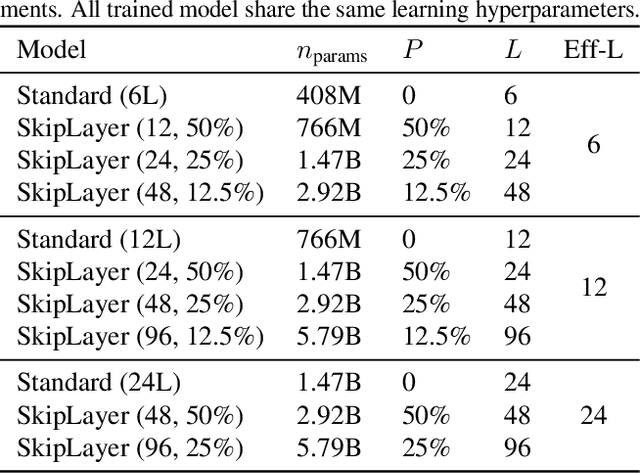
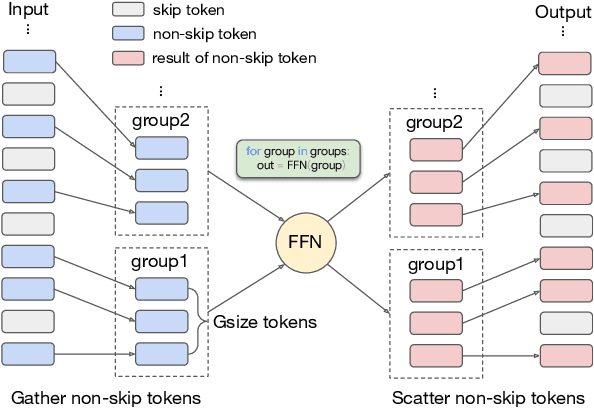
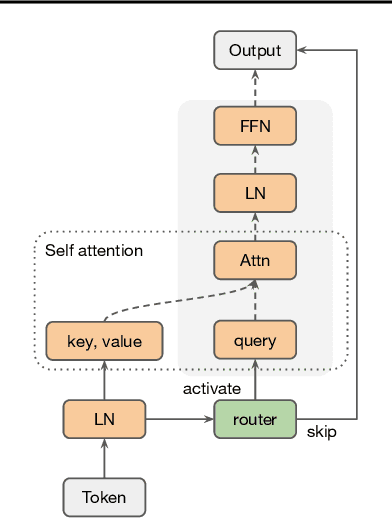

Abstract:Overparameterized large-scale language models have impressive generalization performance of in-context few-shot learning. However, most language models allocate the same amount of parameters or computation to each token, disregarding the complexity or importance of the input data. We argue that in language model pretraining, a variable amount of computation should be assigned to different tokens, and this can be efficiently achieved via a simple routing mechanism. Different from conventional early stopping techniques where tokens can early exit at only early layers, we propose a more general method that dynamically skips the execution of a layer (or module) for any input token with a binary router. In our extensive evaluation across 24 NLP tasks, we demonstrate that the proposed method can significantly improve the 1-shot performance compared to other competitive baselines only at mild extra cost for inference.
TEC-Net: Vision Transformer Embrace Convolutional Neural Networks for Medical Image Segmentation
Jun 07, 2023



Abstract:The hybrid architecture of convolution neural networks (CNN) and Transformer has been the most popular method for medical image segmentation. However, the existing networks based on the hybrid architecture suffer from two problems. First, although the CNN branch can capture image local features by using convolution operation, the vanilla convolution is unable to achieve adaptive extraction of image features. Second, although the Transformer branch can model the global information of images, the conventional self-attention only focuses on the spatial self-attention of images and ignores the channel and cross-dimensional self-attention leading to low segmentation accuracy for medical images with complex backgrounds. To solve these problems, we propose vision Transformer embrace convolutional neural networks for medical image segmentation (TEC-Net). Our network has two advantages. First, dynamic deformable convolution (DDConv) is designed in the CNN branch, which not only overcomes the difficulty of adaptive feature extraction using fixed-size convolution kernels, but also solves the defect that different inputs share the same convolution kernel parameters, effectively improving the feature expression ability of CNN branch. Second, in the Transformer branch, a (shifted)-window adaptive complementary attention module ((S)W-ACAM) and compact convolutional projection are designed to enable the network to fully learn the cross-dimensional long-range dependency of medical images with few parameters and calculations. Experimental results show that the proposed TEC-Net provides better medical image segmentation results than SOTA methods including CNN and Transformer networks. In addition, our TEC-Net requires fewer parameters and computational costs and does not rely on pre-training. The code is publicly available at https://github.com/SR0920/TEC-Net.
CiT-Net: Convolutional Neural Networks Hand in Hand with Vision Transformers for Medical Image Segmentation
Jun 06, 2023



Abstract:The hybrid architecture of convolutional neural networks (CNNs) and Transformer are very popular for medical image segmentation. However, it suffers from two challenges. First, although a CNNs branch can capture the local image features using vanilla convolution, it cannot achieve adaptive feature learning. Second, although a Transformer branch can capture the global features, it ignores the channel and cross-dimensional self-attention, resulting in a low segmentation accuracy on complex-content images. To address these challenges, we propose a novel hybrid architecture of convolutional neural networks hand in hand with vision Transformers (CiT-Net) for medical image segmentation. Our network has two advantages. First, we design a dynamic deformable convolution and apply it to the CNNs branch, which overcomes the weak feature extraction ability due to fixed-size convolution kernels and the stiff design of sharing kernel parameters among different inputs. Second, we design a shifted-window adaptive complementary attention module and a compact convolutional projection. We apply them to the Transformer branch to learn the cross-dimensional long-term dependency for medical images. Experimental results show that our CiT-Net provides better medical image segmentation results than popular SOTA methods. Besides, our CiT-Net requires lower parameters and less computational costs and does not rely on pre-training. The code is publicly available at https://github.com/SR0920/CiT-Net.
 Add to Chrome
Add to Chrome Add to Firefox
Add to Firefox Add to Edge
Add to Edge